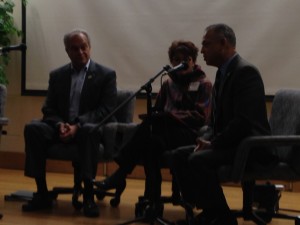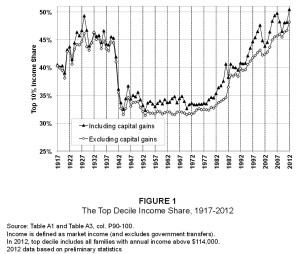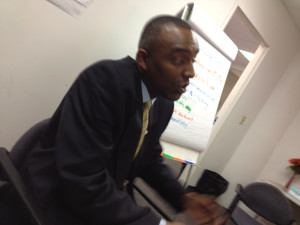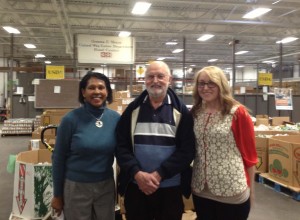Nicholas Kristof & Sheryl WuDunn discuss ways to address opportunity gap
Posted: October 3, 2014 Filed under: Education, General, Income Leave a comment »Pulitzer Prize-winning journalists Nicholas Kristof and Sheryl WuDunn’s new book “A Path Appears” looks at barriers to opportunity around the world, and what can be done to overcome them. Some of those barriers are already in place at the beginning. As WuDunn puts it, some kids are born “behind the starting line.” She says a child born in the bottom 20 percent of the economic spectrum has a one in 12.7 percent chance of making it to the top 20 percent.
WuDunn and Kristof spoke at Sacred Heart University on Friday to talk about the book. WSHU’s Craig LeMoult asked them about the gap, and how it can be addressed with early intervention.
WuDunn says by the age of four, a child of professionals has heard 30 million more words than the child of parents on welfare. That gap can make a significant difference in a child’s development.
“Part of that is an income issue,” says Kristof. “People don’t have resources for babysitter, or may send somebody to a child care program that may be inadequate. But it’s also, to some degree, cultural.”
Kristof says the gap between wealthy and poor children is increasing.
“Middle class parents have been investing more and more and more in their kids’ enrichment programs, and sending their kids to music lessons, then chess lessons, and soccer practice,” he says. “So the gap in those enrichment programs has gotten greater over the last generation, rather than smaller.”
But, Kristof says, it’s a mistake to think there’s not much that we can do to narrow that gap. Here’s what they had to say about early interventions that can make a difference:
“There are very very few people who don’t want the best for their kids,” says Kristof. “And where there are shortcomings, they may be raising their child the way they were raised. And if they get some support, some parental coaching, some help – especially with the incredibly difficult job of being a single parent – then they can dramatically improve those outcomes.”
In particular, Kristof and WuDunn point to the effectiveness of the Nurse Family Partnership, which provides coaching to new parents, even before a child is born. Teaching parents not to smoke or drink, and to breastfeed and hug a baby, can have a huge impact on a child’s development. They say families who get coaching from the Nurse Family Partnership see a 79 percent drop in state-verified child abuse, and the children are half as likely to be arrested by age of 15.
A program that’s working to close that 30 million word gap is Reach Out and Read, which provides books to low income families to help with the cognitive development of children. The program provides books, and doctors “prescribe” nightly bedtime stories to families. Here’s Kristof and WuDunn describing the program.
The cost is $20 per child per year. But Kristof says only a third of children who would benefit from the program in the U.S. get that intervention.
Kristof says unlike the U.S., economic inequality has declined globally. In particular, he says one of the great global changes has been an increase in literacy.
You can hear the full audio of Kristof and WuDunn’s discussion here.
New Haven starts removing controversial fence between public housing and neighboring Hamden
Posted: May 13, 2014 Filed under: Housing, Income, Politics Leave a comment » New Haven began demolishing a fence on Monday that for 50 years separated a public housing complex in the city from the town of Hamden. For some, the fence had become a symbol of racial and economic division between two communities. The economic dividing line here is actually not one of the starkest in a state with one of the widest income disparities in the country. The most recent Census figures show median family income on the New Haven side was around $33,000, and it was about $70,000 on the Hamden side. But few places have anything as symbolically and literally divisive as the fence.Listen to Craig LeMoult’s story here:
City mayors describe inequality with suburbs
Posted: April 30, 2014 Filed under: Housing, Income, Politics Leave a comment »
(L to R) Former New Haven Mayor John DeStefano, Norwich Mayor Deb Hinchey, Harford Mayor Pedro Segarra
Hartford Mayor Pedro Segarra said for the most part, Connecticut is a liberal state.
“I just think that when it comes to protecting people’s wallets, we’re a lot more conservative.”
Segarra said the fiscally conservative suburban towns aren’t willing to step in to help the state’s larger cities. Former New Haven mayor John DeStefano said Connecticut’s three biggest cities have nearly three quarters of the state’s affordable housing stock.
“The choices made 100 years ago and the choices that many of the communities of CT continue to make about who they zone out, has resulted in a separating of populations and concentrations of poverty and wealth in the state.”
That poverty is also concentrated in some of Connecticut’s smaller cities, like Norwich. Norwich Mayor Deb Hinchey, said the cities all wind up fighting for a finite amount of money.
“And where I become concerned about the inequalities is where that finite group of dollars isn’t disbursed evenly throughout the state.”
Hinchey said the state needs to reform its tax laws to be more fair. DeStefano, who retired last year after 10 terms in office, laughed at that, and said he could tell she’s new to the job.
DeStefano said cities in Connecticut need to take action to reduce their own economic inequality, rather than waiting for the state to take steps. Segarra challenged DeStefano on that, suggesting Hartford has a harder time making changes to impact the economic health of the city. Here’s their exchange.
Segarra said his administration is working on building housing to attract those higher-income people to live in Hartford. In New Haven, DeStefano provided incentives for Yale University employees to live in the city. Yale is the city’s largest employer, and provides more than $15 million a year in payments to support city services.
“The Undercover Economist” on the definition of poverty, and why we should care about inequality
Posted: January 13, 2014 Filed under: Income Leave a comment »Financial writer Tim Harford spoke with NPR’s David Greene today on Morning Edition about what poverty means now. Harford is the author of the new book The Undercover Economist Strikes Back.
Harford points out the definition of the poverty line is based on the cost of food needs over 50 years ago. While the calculation today reflects an increase in the price of food, it doesn’t include other common expenses today, like a cell phone and other bills.
“This goes back to Adam Smith writing in the late 18th century. Smith said that a man would be ashamed to appear in public without a linen shirt. And then he pointed out that the Greeks and the Romans — even the emperors — didn’t have linen shirts. His point is that poverty is partly about not having enough money to buy what society expects you to have. If you don’t have enough money to meet those social expectations, people will think of you as poor and you will think of yourself as poor. That’s not to say that poverty is totally relative, but it is saying it’s subjective — it’s a social condition. And he’s got to be right in some fundamental way about that.
“It’s about more than survival. It’s also about: Can you participate in social conversations. Are you ashamed to be seen in public or not? There is some controversy about whether that sort of thing should count for the poverty line or not.”
Harford said considering income inequality is “very contested, because there are just so many ways to think about it.”
“Are you comparing the very richest to the very poorest? Are you looking at the assets that people have? Are you just looking at their income? What we can be reasonably confident of saying is that inequality has been rising.”
So why should we care?
“Whether inequality really damages a country as a whole is less clear. I think the main argument that it’s a problem is that it starts to corrode your political system. You get fewer and fewer people with more and more money who are able to have a disproportionate influence on political priorities through their campaigning, their lobbying, their political donations. And if that happens then you’re moving further and further away from the ideals of a democracy.”
You can hear the full interview with Tim Harford here.
Malloy discusses disparity and workforce training with National Governor’s Association
Posted: October 22, 2013 Filed under: Education, Income Leave a comment » At a summit of the National Governor’s Association in Stamford on Tuesday, Connecticut Governor Dannel Malloy spoke with Oklahoma Governor Mary Fallin and others about the economic importance of education and workforce training. You can listen to Craig LeMoult’s report here.Governor Fallin said 50 years ago, 80 percent of middle class jobs in the country required just a high school degree or less. “Today that number is 35 percent of our jobs require a high school degree or less, and two thirds of those jobs will pay less than $25,000 a year,” said Fallon.
Malloy said there’s no reason to believe Connecticut is not leading the country in the decline in the number of jobs available to people without a higher education degree. “And then, in some of our urban areas, we have a larger than we should find acceptable numbers of students that don’t even get the high school degree, at least in the standard 13 years,” said Malloy. “So this is a big questions for all of us.”
Malloy discussed efforts to address the state’s disparity in greater detail. Listen to his comments here:
Malloy said when cities like Bridgeport are graduating only about 65 percent of their students, “that is not a roadmap to recovery” or closing the economic gap. He said Connecticut’s educational reform package is designed to reduce the achievement gap between wealthy and the poor students. And the new Board of Regents for Higher Education, which brings together community colleges, state universities and an online college, is intended to help the state create a system that prepares more young people to be ready for the workforce.
Wealthiest having much easier time bouncing back from recession
Posted: September 12, 2013 Filed under: General, Income, Politics Leave a comment »A new study by Emmanuel Saez at U.C. Berkeley says that the economic recovery has been far more generous to the wealthiest Americans than to the rest of the country. From 2009-2012, according to the study, incomes of the top 1% of Americans grew by 31.4% while the incomes of the other 99% grew just 0.4%. This chart from study shows what percentage of the total income share was held by the top 10% (decile) from 1917-2012.

Source: “Striking it Richer: The Evolution of Top Incomes in the United States” by Emmanuel Saez, UC Berkeley
As you can see, there was a serious drop-off around the time of World War II, and the levels stayed fairly constant between 30-35% until the late 1970s. They’ve now climbed back up to an all-time high.
The study was a topic of discussion today on the Diane Rehm Show on NPR. You can listen to that conversation here.
Stephanie Coontz of the Council on Contemporary Families said on the show that this is a long-term change.
“I think it’s a mistake to just think of it in terms of the recession,” she said. “It’s actually a 30 year process that has turned around all of the trends we had after the Great Depression and the move toward greater equality, and greater sense of community among the rich as well as the poor. I think the social implications of this are profound at all levels of society.”
Wall Street Journal columnist Dante Chinni, who directs the American Communities Project at American University discussed the causes of the growing disparity.
“You have the decline of good paying jobs, of manufacturing jobs,” he said. “And they were hard jobs, but they paid well. And they’ve disappeared. And that’s made life very hard. Also, automation. There are just fewer jobs available for people who don’t have a lot of education, and a lot of good skills training.”
The show’s other guest Columbia University journalism professor Thomas Edsall recently wrote a blog post for the New York Times on whether the government can actually do anything about inequality. On a somewhat related note, economist Steven Lanza looked at the issue of what difference government policies can make on the economy in Connecticut. His answer: not much. A WSHU story on his paper is here.
Also today, NPR Morning Edition’s Steve Inskeep spoke with Tyler Cowan, author of the book “Average Is Over: Powering America Beyond the Age of the Great Stagnation.” Cowan predicts the future means more people rising up to much greater wealth, as well as more clustering in a kind of “lower-middle class existence.”
“It will be a very strange world, I think,” he said. “We will be returning to historical levels of inequality. We’ll view post-war America as a kind of strange interlude not to be repeated. It won’t be the dreams that we all had that virtually all incomes go up in lockstep at three percent a year. It hurts to give that up. It will mean some very real increases in economic fragility for a lot of people.”
You can listen to Cowan’s conversation with Inskeep here.
What do you think? Let us know in the comments, email disparity@wshu.org or tweet us at @CTdisparity.
Trying to reach the bottom rung of the economic ladder
Posted: July 25, 2013 Filed under: Employment, Income Leave a comment »
Rodney Moore of New Haven Family Alliance, speaking with participants in the Project Success program
A report out this week by researchers at Harvard and U.C. Berkeley found the chance that someone born into the bottom fifth of the economic ladder in Connecticut could rise to the top fifth is about 8%. For some young low-income people, even the bottom rung of that economic ladder feels out of reach. One program in New Haven is working to help them start that climb.
Listen to Craig LeMoult’s story here:
lemoult_projectsuccess_130724_web
The New Haven Family Alliance runs a program called Project Success to help young people who don’t see a path for themselves to jobs in the regular economy. Economists say even with a regular job, climbing out of poverty is a challenge.
Conn. legislature considering minimum wage, retirement plan for low-income workers
Posted: May 8, 2013 Filed under: Education, General, Income, Politics Leave a comment »Connecticut’s legislative appropriations subcommittee approved two bills Tuesday related to economic disparity issues – one that would raise the minimum wage, and another that takes steps toward creating a state retirement plan for low income workers.
Hear about both bills here:
dk_bills_130508
The first bill would raise the minimum wage from $8.25 to $9 an hour over the next year and possibly to $9.75 the following year. Democratic State Representative Beth Bye of West Hartford says in the past she voted against raising the minimum wage. But now she says workers need it more than ever:
“What we’re seeing is this widening income disparity, in our state and in our country,” said Bye. “For people who are working full time I think we need to offer this as a way to help them to buy food and afford housing”
State Representative Mitch Bolinsky, a Newtown Republican, says the bill would prevent companies from hiring new employees, particularly teenagers. “The unemployment rate for that class of individual is three times higher than the state rate I see this as a job killing bill and a reason to have more kids on the street with nothing to do this summer,” said Bolinsky.
The bill is different from what Governor Dannel Malloy has proposed, which is to raise the minimum wage by 75 cents over the next two years. The committee bill still needs to be taken up by the House and Senate.
Also, the Appropriations Committee approved a bill that would require an initial feasibility study of a state administered retirement plan for low income workers. It made it through the committee on a mainly party line vote on Tuesday. Representative Jason Perillo of Shelton was one of a number of Republican members of the committee who voted against the bill. Perillo says there are plenty of private firms available to administer retirement plans for low income workers. The bill requires the Connecticut Retirement Security Trust Fund Board to set-up a low income workers fund, if the market feasibility study finds that such a fund would be self-sustaining. The bill heads to the Senate for further action.
Food insecurity a complicated problem in Conn.
Posted: April 10, 2013 Filed under: General, Health, Income, Nutrition Leave a comment »
Katherine Sebastian-Dring who work at the Gemma E. Moran United Way Labor/Food Center stands on the left, next to Bob Davoy who runs a food pantry in downtown New London. Mary Gates (right) is an Americorp VISTA for the New London Food Policy Council.
Recently a national anti-hunger advocacy group ranked Connecticut as the 6th best state for access to affordable and nutritious food—what’s also called community food security. But a study released Wednesday by UConn’s Zwick Center for Food and Resource Policy shows that things are pretty tough in some areas.
You can hear Will Stone’s report on food insecurity here:
ws_foodsecurity_130409
1 in 6 children in New London County is food insecure. That means they and their families don’t have reliable access to affordable food for a number of reasons—transportation, education, geography and income, all play a role.
It’s not all about economic disparity for this issue. The per capita income in the city of New London is $21,000, while neighboring Stonington is almost twice that. But the report shows Stonington still has a higher than average risk of food insecurity.
“Every town in the county has an at-risk population,” says Mary Gates, who’s been conducting focus groups on food insecurity for the New London Food Policy Council. “I want to make sure that people don’t look at Stonington or Mystic and say there can’t be hungry people there.”
Conn. NAACP describes “urban Apartheid”
Posted: April 10, 2013 Filed under: Employment, General, Housing, Income Leave a comment »NAACP members in greater New Haven are calling on the federal and state government to re-examine the disparities between low-income people of color in urban neighborhoods and white people in the suburbs. The report, called “Urban Apartheid,” looks at disparities in areas like education, income, and housing.
You can hear Will Stone’s story on the report here:
ws_naacp_130329
NAACP Chapter President James Rawlings says the findings show that place matters. He means neighborhoods in and around New Haven where, for example, the poor are six times less likely to have access to transportation, which in turn affects their chances of employment. A quarter of African American men in the region were unemployed in 2011. Rawlings says it all comes back to the educational achievement gap, and he says the key is removing children from what he calls “unhealthy communities.”
“The transportation system isn’t there to support the children, libraries are not there to support the child, the family wrap-around services are not there to support the child,” he says.
The NAACP is recommending that affordable housing be placed in more suburban communities, where the air is cleaner and there’s less crime.




Recent Comments